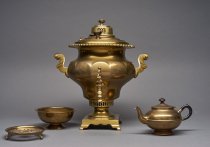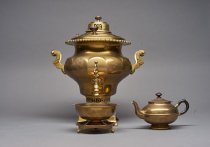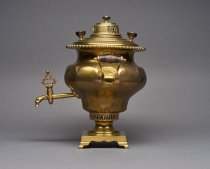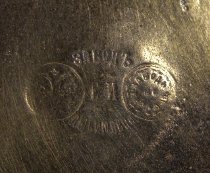Object Record
Images





Metadata
Catalog Number |
1934.1.306.1-4 |
Object Name |
Urn, Tea |
Description |
Russian antique brass Samovar (tea urn) and tray, waste bowl and tea pot. The samovar is brass, with a circular cap of brown wood. The collar is cylindrical with three large squares with open work interlaced circles. The lid is circular with five graduated steps to the rim, one round brown wooden knob on either side of the top surface near the rim edge and a hinged steam cap. There are 12 scallops around the inverted pear-shaped body with an extended, beaded rim, low neck, and curved handle with wooden spool at either side of the body. It has a long spout with an open work spigot, and a circular foot attached to the square ogee-footed base which has a hinged circular plate and an internal charcoal tube. There is a maker's mark near the right handle. Samovars like this one have been used to make tea in Russia since at least the 1770s. Samovars are defined by their central flume into which burning coals or pinecones are placed to boil water. The water is then poured into a kettle holding tea concentrate, called zavarka, to steep on top of the samovar. This samovar was made by the Vorontsov Brothers, whose factory operated in the traditionally metalworking city of Tula from 1854-1919. For the wealthy, a highly decorated samovar was a sign of status, while simple samovars used in peasant homes were often the home's only source of warmth. Today, the samovar conjures ideas of the Russian hearth and home. |
Title |
Samovar Set |
Date |
c. 1860 |
Role of Creator |
Manufacturer |
Creator |
Vorontsov Brothers |
Material |
brass |
Dimensions |
H-44.45 W-37.465 D-34.925 cm |
Credit line |
Gift of Mr. and Mrs. Louis Bailey Audigier |
Place of Origin |
Asia/Russia/Tul’skaya Oblast’/Tula |
Culture |
Russian |
Subjects |
Beverages Heat Samovars Social classes Tea Tea industry Trade |
Relation |
Show Related Records... |
